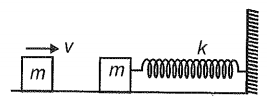The gravitational field in a region is given by . Work done by this field is zero, when a particle is moved along the line
(1) 3x + 4y = 2
(2) 3x + 3y = 5
(3) x + 3y = 2
(4) 3y + x = 1
Five balls are placed one after another along a straight line as shown in the figure. Initially, all the balls are at rest. Then the second ball is projected with speed towards the third ball. Mark the correct statement(s). (Assume all collisions to be head-on and elastic):
1. The total number of collisions in the process is 5.
2. The velocity of separation between the first and fifth ball after the last possible collision is
3. Finally, three balls remain stationary.
4. All of the above are correct.
A body of mass \(2\) kg moving with a velocity of \(3\) m/s collides with a body of mass of \(1\) kg moving with a velocity of \(4\) m/s in the opposite direction. If the collision is head-on and completely inelastic, then the wrong statement is:
| 1. | Both bodies move together with a velocity \((2/3)\) m/s. |
| 2. | The momentum of the system is \(2\) kg-m/s throughout. |
| 3. | The momentum of the system is \(10\) kg-m/s. |
| 4. | The loss of KE for the system is \((49/3)\) J. |
1. \(\dfrac{2 um}{m}\)
2. \(\dfrac{2 um}{M}\)
3. \(\dfrac{2 u}{1 + {m \over M}}\)
4. \(\dfrac{2 u}{1 + {M \over m}}\)

1. \(v\sqrt{\dfrac{m}{k}}\)
2. \(v\sqrt{\dfrac{2m}{k}}\)
3. \(m\sqrt{\dfrac{v}{2k}}\)
4. \(v\sqrt{\dfrac{m}{2k}}\)
Two identical balls of mass 1 kg each moving towards each other with velocities of 3 m/s and 5 m/s respectively. The magnitude of the velocities of respective balls after the perfectly elastic head-on collision is
(1) 3 m/s, 5 m/s
(2) 5 m/s, 3 m/s
(3) 4 m/s, 4 m/s
(4) 6 m/s, 2 m/sIf the two masses are equal
A body is under uniform circular motion, its kinetic energy.
1. depends on the direction of velocity.
2. depends on acceleration.
3. remains unchanged.
4. all of these.
A particle of mass m is moving in a circular path of constant radius r such that its centripetal acceleration is varying with time t as ,where k is constant. The power delivered to the particle by the force acting on it is
(1)
(2)
(3)
(4) Zero
The ratio of the kinetic energy of a particle projected from the ground at the highest point to point of projection is 1/4. The angle of projection with horizontal is
(1) 30°
(2) 60°
(3) 45°
(4) 53°
A bob is suspended from a peg on a wall by a massless string of length L. If it is given velocity at the lowest point, then angular amplitude with which body will oscillate is
(1) 60°
(2) 90°
(3) 75°
(4) 30°







